Halfway buried in the sand lays the forgotten skull of a whale. Its flesh has been removed by the gentle erosion sustained by the pulsating sea.
Its white form contrasts the dark sand layer covering the beach. Its rostrum points towards the only island in the middle of the gulf populated by trees, a safe refuge from the elements for those who dare to venture. Could that be the habitat the insects I am looking for have survived in?
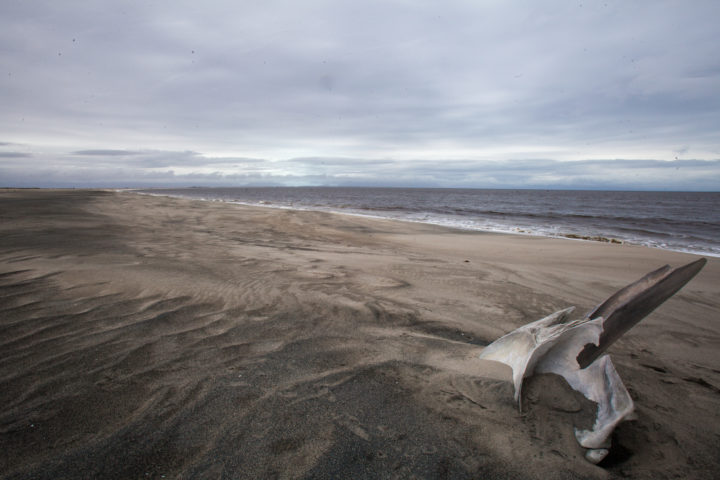
A few feet away from the inanimate whale remains, life commences. Two brown dappled Magellanic oystercatcher eggs lay partially protected from the elements within their simple sand nest.
Behind the whale skull, half a mile across the dunes where the glaciers vanish into the sea, Diablo’s Island beckons.
Its soft ground is composed of generations of moss, growing on top of each other like coral. Their dampened nature is the perfect habitat for moist-loving insects.
As I step onto the island, strange and small endemic crimson-red plants adorn the ground. Their filamentous leaves bear transparent droplets of seemingly harmless liquid. Close inspection reveals their sinister purpose. The remains of partially digested flies lay trapped within, providing the carnivorous plant with vital nutrients to continue its development on the impoverished soil.
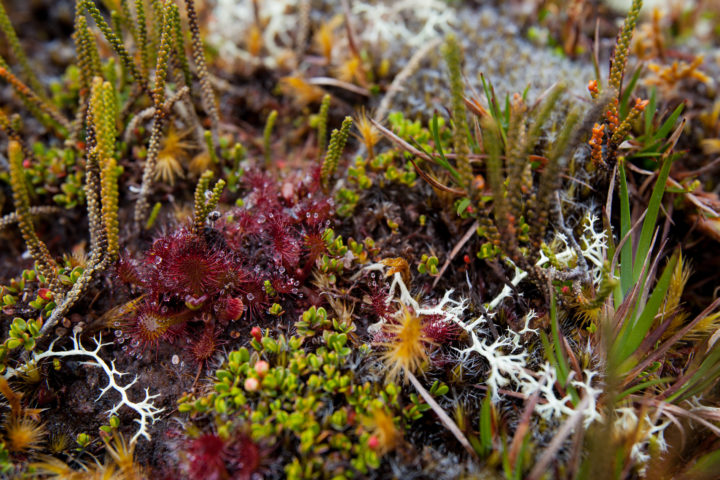
Shaped by the strong winds and the lack of firm soil to grow on, the few trees on the island are a smaller version of those inhabiting the Andean slopes. The tallest border a small pond where its crystal-clear waters are stained by the dissolved organic matter of the surrounding wetland.
Inch-long frogs seek refuge from the wind in the cavities of broken and decaying stumps. There, they remain motionless, camouflaged by their exquisite coloration resembling the variegated yellow tones of the small moldering tree leaves surrounding them.
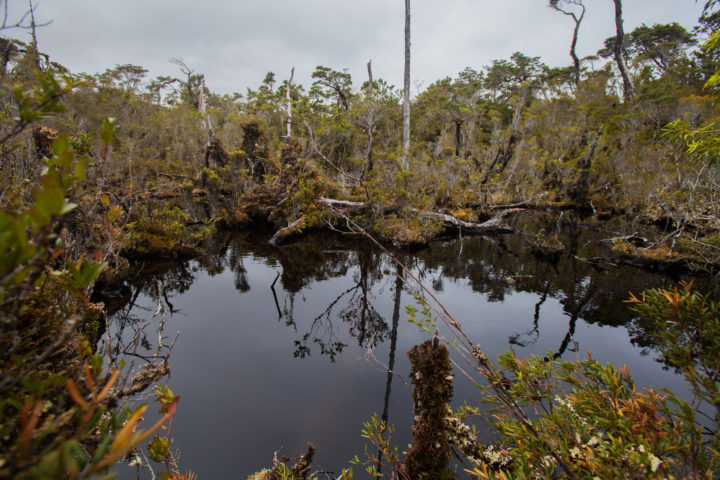
The constant wind ceases momentarily. The island stands till. Silence announces the advent of danger. Small dark-colored damselflies glide effortlessly over open areas, swiftly hunting unaware moss-inhabiting insects in the air. Below, predatory beetles emerge from cavities in the soft ground. They scour the moss surface in search of injured insects. Disoriented wind-drifted new comers become rapidly eradicated from the unfamiliar landscape. Alas, the group of flies I am looking for is not here.
Bordering the northern edge of the island, the sediment-rich waters of San Tadeo’s river meanders for miles, originating from San Quintin glacier to the east, augmenting its volume from the waters of unnamed melted glaciers in the north.
The clouded river carries a mournful sentiment conceived by the vanished endemic tribes that once navigated its pristine waters.
Digging shallowly in the sand below discloses fresh water seeping through the sand underneath the island. This seemingly insignificant act elucidates the need of a healthy flow of glacial melts to sustain the current island’s ecosystem.
A few hundred feet upstream from the island, Chile’s largest beaver-like endemic rodent, the Coipo, swims across the cold channel.
Close by, among the tall grass above the waterline, the lamenting wind reveals the exposed grave site of an adult Sei whale. Its complete skeleton stands as testimony of the unpredictable tide surrounding the island’s ominous name.
Unlike its counterpart across the dunes, the bones are covered by a colorful film of algae and diatoms nourished by the adjacent river. Minute black primitive insects are distributed throughout the multicolored surface. They congregate in small groups, feeding on nutrients from the remaining fat residues impregnated in the moist microscopic bone cavities.
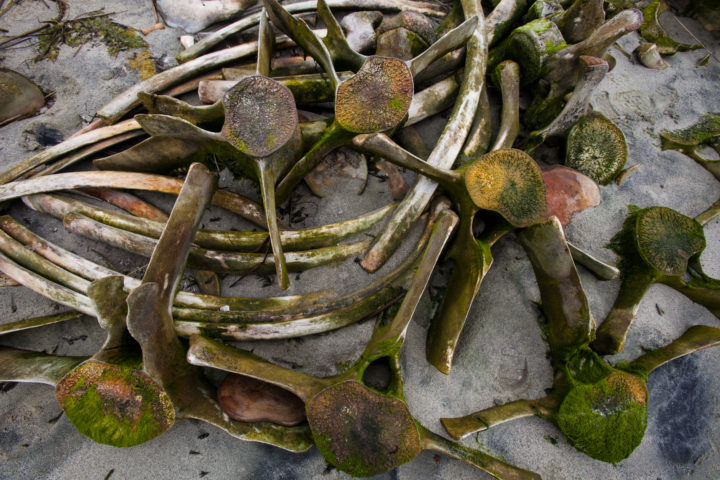
Back in camp, I stand barefoot at the ocean’s edge. Its cold waters aid in relieving the pain of my dislocated ankle. There, I look into the horizon, contemplating the sunset. A stream of transient thoughts disrupts the moment: Am I too early in the year to find the insects I am looking for? Can flying insects inhabit the dunes’ extremes? If they are here, how have they evolved to cope with such environmental conditions?
Behind a dune, protected from the southern winds, sand is being blown in a vortex. At that moment, the wind pauses momentarily but the vortex persists. A closer look reveals that the revolving sand is actually an insect swarm. The flying insects belong to the winter crane fly family (Trichoceridae). At last, I found the group I was looking for.
To my surprise, the species seems unusual. Unlike other species known to inhabit Patagonia, this species exhibits reduced leg segments.
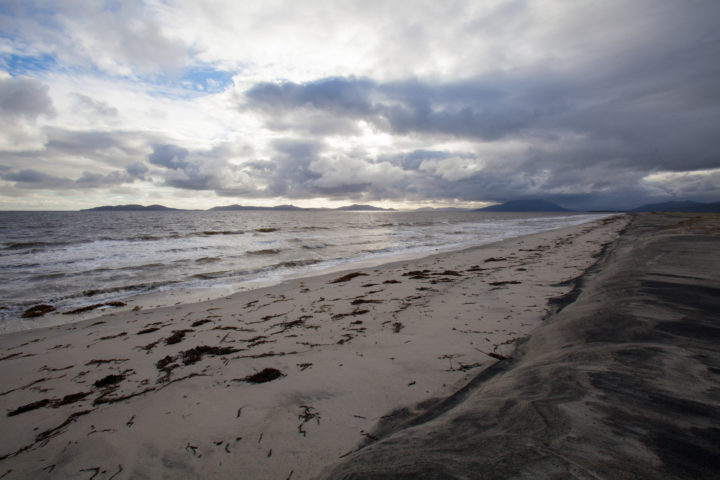
At dusk the entire population disappears
stand in the same place at the same time the following day, but the site is barren. As I examine the close surroundings, I locate a single male. He flies around looking for others, unaware that the rest of the population has vanished. I stand motionless, observing. As the sun hides behind the horizon, it takes with it the warmth in the vicinity. The temperature drops even faster with the arrival of the southern winds. The fly’s energy is fading. The body fat he uses to power his flight is depleting rapidly. Unable to fight the elements any longer he falls onto the sand below. Within minutes, his body becomes entombed by the ever-shifting sands. Looking for another population to emerge in a close by location, I continue my search for the species throughout the following days. All in vain. Fifteen miles upstream from the Island, across a strenuous bog, lays San Rafael Lagoon, bearing its name from San Rafael glacier arising directly from the Northern Patagonia Ice Field. With the Andean mountains in the east, the narrow fjord channels to the west and the twenty-mile-wide Isthmus to the south, the Pacific Ocean waters become encapsulated within these formidable barriers. As I rest on the lagoon’s beach, I ponder the whereabouts of the strange insect I found in the days prior, evaluating the evidence. The remarkable modification of their reduced legs, which a closely related species uses for hanging on to vegetation, suggests this species is unable to rest, leading to an unusually short adult lifespan. Meanwhile, one hundred yards in front of me, I witness in shock the accelerated melting rate of a school bus-sized iceberg disappearing into the calm waters within hours. Further ahead in the middle of the lagoon, as they float adrift, collapsed fragments of the glacier display a kaleidoscope of vivid blue and green hues. Among them near the base of the glacier, the lagoon’s top predator, an adult leopard seal, rests peacefully on top of a flat iceberg unaware that the glacier he fully depends on is slowly disappearing.
